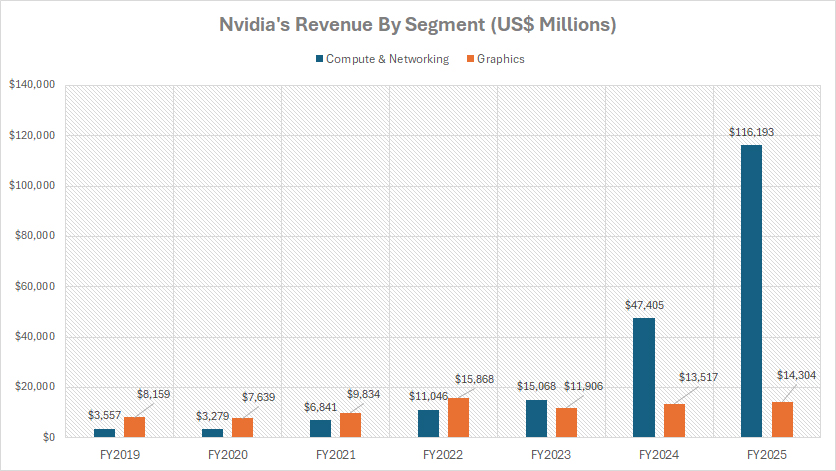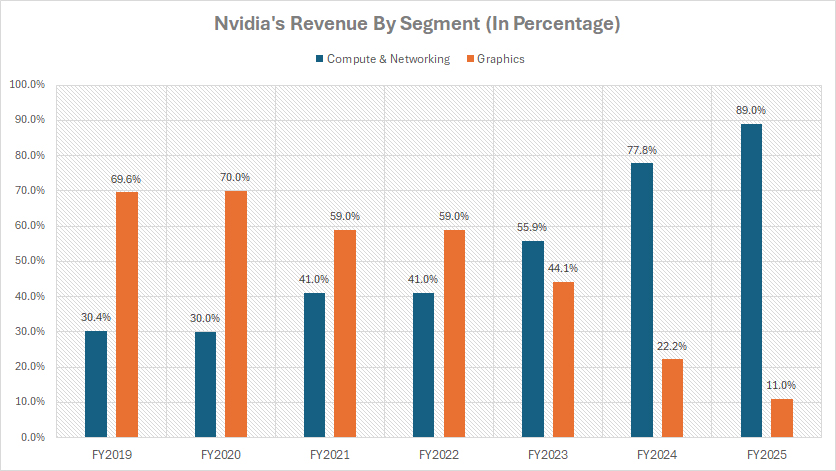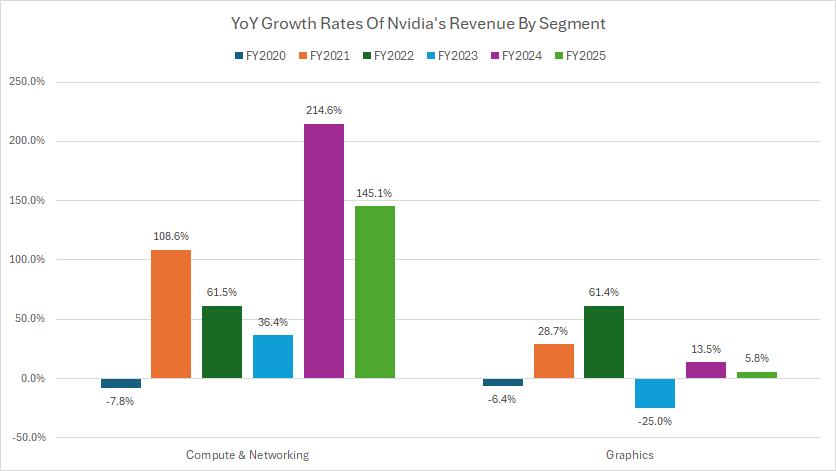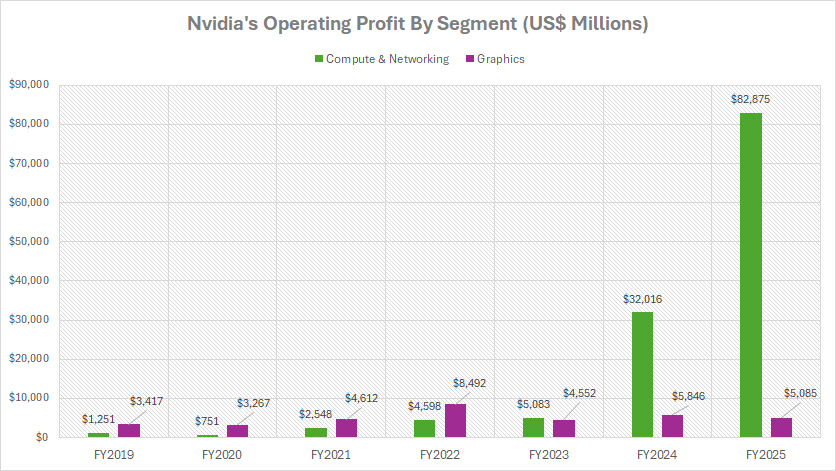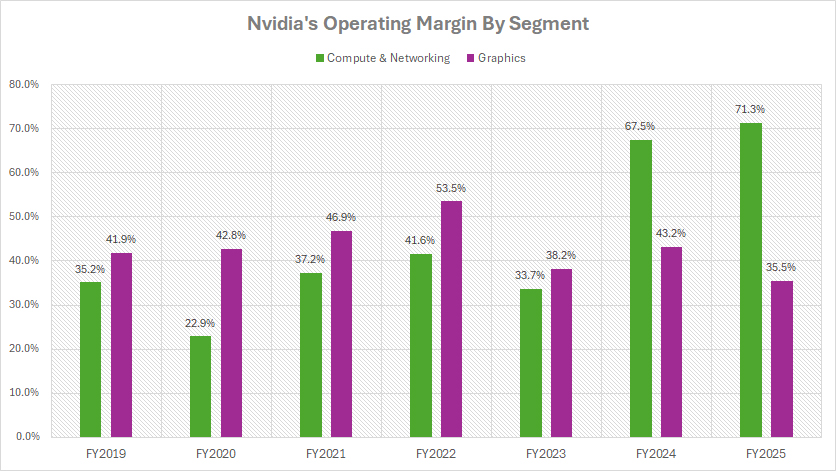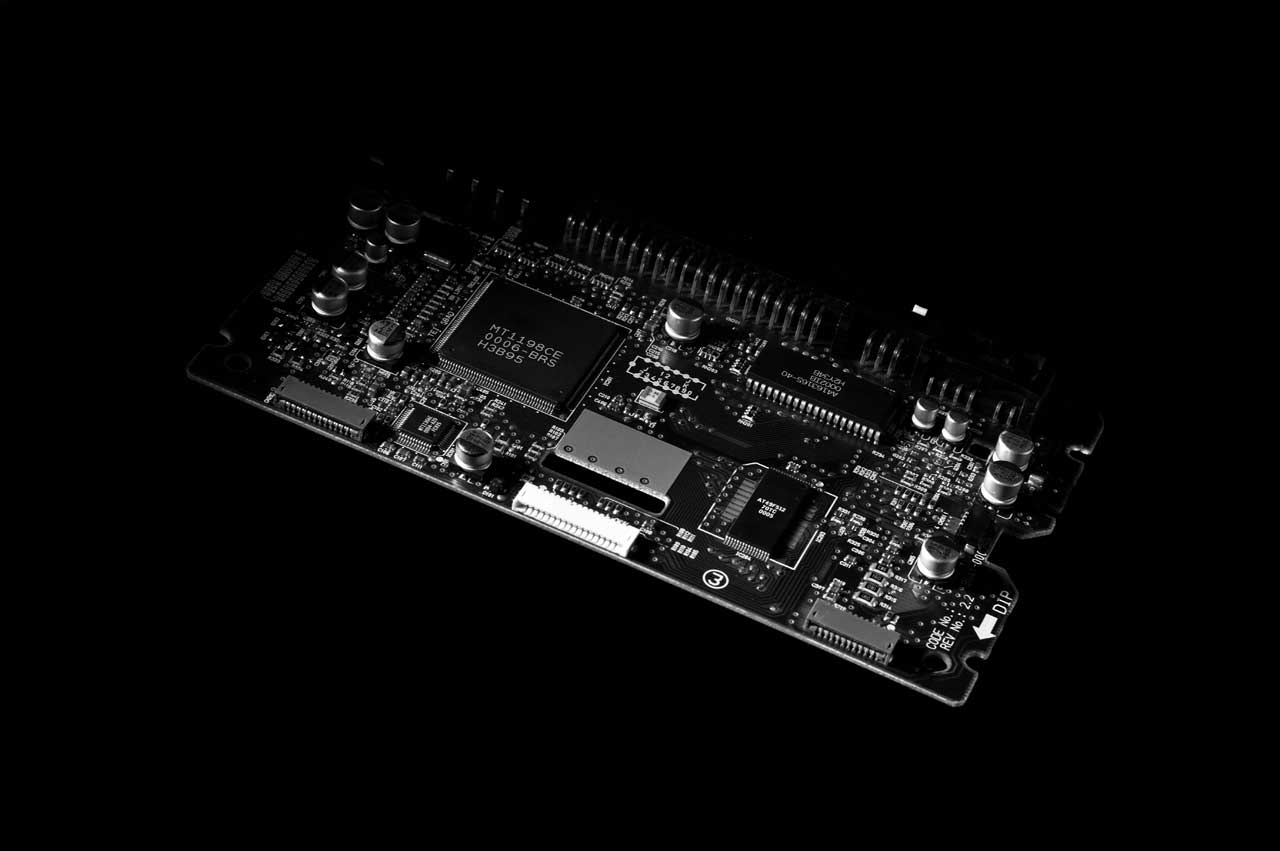
Nvidia chipset. Pexels Images.
This article covers Nvidia’s revenue distribution by segment. Nvidia operates through two main segments: Compute & Networking and Graphics. Apart from breaking down the revenue streams by segment, we also delve into Nvidia’s profit and margin for each segment.
Investors interested in Nvidia’s other key statistics may find more resources on these pages:
- Nvidia revenue by market and product segment,
- Nvidia revenue by country: U.S., Singapore, Taiwan, etc., and
- Nvidia vs Palantir: profit margin analysis.
Let’s look at the results!
Please use the table of contents to navigate this page.
Table Of Contents
Definitions And Overview
O2. What contributes to Nvidia’s significant revenue growth within the Compute & Networking segment?
Revenue By Segment
C1. Revenue From The Compute & Networking And Graphics Segments
C2. Percentage Of Revenue From The Compute & Networking And Graphics Segments
Revenue Growth
C3. YoY Growth Rates Of Revenue From The Compute & Networking And Graphics Segments
Profit And Margin By Segment
D1. Operating Profit From The Compute & Networking And Graphics Segments
D2. Operating Margin From The Compute & Networking And Graphics Segments
Summary And Reference
S1. Summary
S2. References and Credits
S3. Disclosure
Definitions
To help readers understand the content better, the following terms and glossaries have been provided.
Compute & Networking: Nvidia’s Compute & Networking segment encompasses the company’s products, services, and solutions aimed at delivering high-performance computing and networking capabilities.
This segment includes the company’s data center platforms and systems for AI, high-performance computing (HPC), and accelerated computing. It also covers networking products and solutions that facilitate high-speed connectivity and efficient data processing across various computing environments.
These offerings are pivotal for applications in cloud computing, data analytics, scientific research, and more, enabling advancements in AI, deep learning, and other compute-intensive tasks.
Nvidia’s technology in this segment is designed to cater to the needs of enterprises, cloud service providers, and research institutions, among others, driving innovation and performance improvements across numerous industries.
Graphics: Nvidia’s Graphics segment refers to the part of the company focusing on the development and manufacturing of graphics processing units (GPUs) and related technologies for a wide variety of applications.
This includes GPUs for gaming, professional visualization (such as design and content creation), data centers, and more. The segment is known for innovations in computer graphics, providing hardware that supports high-performance gaming, real-time ray tracing, and AI-powered features.
Nvidia’s graphics products are widely used in personal computers, workstations, servers, and gaming consoles, making it a key player in the graphics industry.
What contributes to Nvidia’s significant revenue growth within the Compute & Networking segment?
Nvidia’s significant revenue growth within the Compute & Networking segment can be attributed to several key factors:
- Data Center Demand: The increasing demand for data center solutions, driven by the rise of cloud computing, artificial intelligence (AI), and high-performance computing (HPC), has significantly boosted Nvidia’s revenue. Their data center platforms and systems are essential for AI, HPC, and accelerated computing applications.
- AI and Deep Learning: Nvidia’s advancements in AI and deep learning technologies have positioned them as a leader in the industry. Their GPUs are widely used for training and deploying AI models, which has led to substantial revenue growth.
- Networking Solutions: Nvidia’s networking products and solutions, which facilitate high-speed connectivity and efficient data processing, have also contributed to their revenue growth. These products are crucial for various computing environments, including cloud computing and data analytics.
- Innovative Products: The introduction of innovative products, such as the Blackwell AI supercomputers, has driven significant sales and revenue growth. Nvidia’s ability to ramp up massive-scale production of these advanced products has been a key factor.
- Enterprise and Research Adoption: Nvidia’s technology is widely adopted by enterprises, cloud service providers, and research institutions. This broad adoption across various industries has driven revenue growth by enabling advancements in AI, deep learning, and other compute-intensive tasks.
These factors combined have propelled Nvidia’s Compute & Networking segment to achieve remarkable revenue growth.
Revenue From The Compute & Networking And Graphics Segments
Nvidia-revenue-by-segment
(click image to expand)
The definitions of Nvidia’s segments are available here: Compute & Networking and Graphics.
Nvidia earns the majority of its revenue from the Compute & Networking segment, as shown in the chart above.
In fiscal year 2025, Nvidia’s revenue from the Compute & Networking segment surged to $116.2 billion, more than doubling the $47.4 billion reported in fiscal year 2024. In fiscal year 2023, Nvidia earned $15.1 billion, marking a significant rise from the $11 billion recorded in fiscal year 2022.
Examining a longer period from fiscal year 2019 to 2025, Nvidia’s revenue from the Compute & Networking segment has skyrocketed by over 30 times, escalating from just $3.6 billion in fiscal year 2019 to a staggering $116.2 billion as of fiscal year 2025.
On the other hand, Nvidia’s revenue from the Graphics segment is significantly smaller compared to the Compute & Networking division. In fiscal year 2024, Nvidia’s revenue from the Graphics sector increased by a modest 6%, reaching $14.3 billion, up from $13.5 billion in the prior year. In fiscal year 2023, Nvidia reported a decline in Graphics segment revenue, with $11.9 billion compared to the previous year’s $15.9 billion.
This marked disparity in growth and revenue between the two segments underscores the predominant role of Compute & Networking in Nvidia’s overall financial performance. The substantial advancements in AI, data centers, and networking technologies have evidently positioned Nvidia’s Compute & Networking segment as a key driver of the company’s impressive revenue trajectory.
Percentage Of Revenue From The Compute & Networking And Graphics Segments
Nvidia-revenue-by-segment-in-percentage
(click image to expand)
The definitions of Nvidia’s segments are available here: Compute & Networking and Graphics.
The data presented in the chart above highlights the significant transformation in Nvidia’s revenue composition over recent years. As of fiscal year 2025, the Compute & Networking segment has become the dominant contributor to Nvidia’s total revenue, accounting for a substantial 89%.
This marks a dramatic increase from fiscal year 2019, when the Compute & Networking segment comprised only 30.4% of the company’s total revenue. This impressive growth underscores the strategic shift and expansion of Nvidia’s business focus towards the Compute & Networking division.
Conversely, the Graphics segment has seen a notable decline in its contribution to Nvidia’s overall revenue. In fiscal year 2019, the Graphics segment was responsible for nearly 70% of Nvidia’s total revenue. However, by fiscal year 2025, its share had dwindled to a mere 11%. This stark contrast reflects the evolving priorities and market dynamics that have influenced Nvidia’s revenue streams over the past few years.
The shift in revenue distribution not only highlights Nvidia’s adaptability and strategic maneuvering in the tech industry but also emphasizes the growing importance of the Compute & Networking segment in driving the company’s future growth and innovation.
YoY Growth Rates Of Revenue From The Compute & Networking And Graphics Segments
Nvidia-yoy-growth-rates-of-revenue-by-segment
(click image to expand)
The definitions of Nvidia’s segments are available here: Compute & Networking and Graphics.
The chart above vividly demonstrates the stark contrast in revenue growth between Nvidia’s Compute & Networking segment and its Graphics segment. Since fiscal year 2023, Nvidia’s Compute & Networking segment has experienced remarkable revenue growth, averaging 132% annually. In stark contrast, the Graphics segment has faced an average annual revenue decline of 2% during the same period.
This disparity highlights the significant shifts within Nvidia’s business model and market focus. The Graphics division, once a major revenue driver, has seen a decline in its contribution over the past three years. This trend underscores the changing dynamics within Nvidia and the broader tech industry, where certain market segments have gained more traction and investment.
Several factors contribute to the impressive revenue growth in the Compute & Networking segment. Foremost among these is the broader market applicability of products in this division. The Compute & Networking segment encompasses data center platforms and systems for artificial intelligence (AI), high-performance computing (HPC), and networking. These technologies have experienced a surge in demand as businesses and industries increasingly adopt AI and cloud computing solutions.
The growing need for powerful computing capabilities to support AI-driven applications, machine learning, big data analytics, and cloud services has driven significant revenue growth in the Compute & Networking segment. Nvidia’s strategic focus on expanding its product offerings in these areas has enabled the company to tap into new revenue streams and secure a stronger position in the tech market.
Overall, the remarkable growth in the Compute & Networking segment reflects Nvidia’s adaptability and foresight in aligning its business with evolving industry trends. This strategic shift underscores the company’s commitment to innovation and its ability to capitalize on emerging opportunities in the tech landscape.
Operating Profit From The Compute & Networking And Graphics Segments
Nvidia-operating-profit-by-segment
(click image to expand)
The definitions of Nvidia’s segments are available here: Compute & Networking and Graphics.
Nvidia’s Graphics division historically enjoyed significantly higher profitability compared to the Compute & Networking segment. This trend was evident in the higher operating profits of the Graphics segment from fiscal years 2019 to 2022.
However, this dynamic began to shift dramatically from fiscal year 2023 onwards. The Compute & Networking segment experienced an extraordinary surge in operating profit, catapulting from $5.1 billion to an astounding $82.9 billion by fiscal year 2025.
This monumental growth positioned the Compute & Networking segment as the primary profit driver for Nvidia, surpassing the Graphics division by a wide margin.
As illustrated in the accompanying chart, the operating profit for the Compute & Networking segment in fiscal year 2025 soared to a remarkable $82.9 billion, vastly overshadowing the $5.1 billion in operating income reported for the Graphics segment.
Meanwhile, the Graphics division faced a notable decline in profitability following its peak operating profit of $8.5 billion in fiscal year 2022.
Since that peak, Nvidia’s operating profit from the Graphics segment has steadily decreased, dropping from $8.5 billion to $5.1 billion. This decline underscores the shifting landscape within Nvidia’s business model and the growing importance of the Compute & Networking segment in the company’s overall financial performance.
Operating Margin From The Compute & Networking And Graphics Segments
Nvidia-operating-margin-by-segment
(click image to expand)
The definitions of Nvidia’s segments are available here: Compute & Networking and Graphics.
Nvidia’s Compute & Networking segment has not only emerged as the primary profit contributor but has also become the company’s most profitable division. This shift marks a pivotal change in Nvidia’s business model and underscores the growing importance of this segment in driving the company’s financial performance.
In fiscal year 2025, the Compute & Networking segment’s operating margin surged to an impressive 71.3%, significantly higher than the 35.5% recorded by the Graphics segment. This remarkable growth highlights the segment’s efficiency and profitability.
The trend of increasing profitability in the Compute & Networking division is evident, with the operating profit margin rising from 35% in fiscal year 2019 to an extraordinary 71% by fiscal year 2025. This substantial increase underscores the segment’s strategic importance and its role in Nvidia’s long-term success.
Conversely, the Graphics division has seen a decline in profitability after reaching its peak operating profit margin of 53.5% in fiscal year 2022. Since then, the operating profit margin has steadily decreased, falling to 35.5% by fiscal year 2025. This downward trend reflects the challenges faced by the Graphics division and the shifting focus within Nvidia’s operations.
On average, from fiscal year 2023 to 2025, the Compute & Networking segment achieved an operating profit margin of 58%, while the Graphics segment’s average operating profit margin was 39%. This significant disparity illustrates the dominant role of the Compute & Networking segment in Nvidia’s overall profitability and its critical contribution to the company’s financial health.
Conclusion
Nvidia’s focus on expanding its Compute & Networking capabilities aligns with the broader industry trend towards AI and data-centric computing, positioning the company for sustained growth in these high-demand areas.
On the other hand, the decline in Graphics segment revenue and profitability indicates a need for strategic reassessment, potentially involving innovation and differentiation to maintain competitiveness in the graphics market.
References and Credits
1. All financial figures presented were obtained and referenced from Nvidia’s quarterly and annual reportspublished on the company’s investor relations page: Nvidia Financial Reports.
2. Pexels Images.
Disclosure
We may use the assistance of artificial intelligence (AI) tools to produce some of the text in this article. However, the data is directly obtained from original sources and meticulously cross-checked by our editors multiple times to ensure its accuracy and reliability.
If you find the information in this article helpful, please consider sharing it on social media. Additionally, providing a link back to this article from any website can help us create more content like this in the future.
Thank you for your support and engagement! Your involvement helps us continue to provide high-quality, reliable content.


